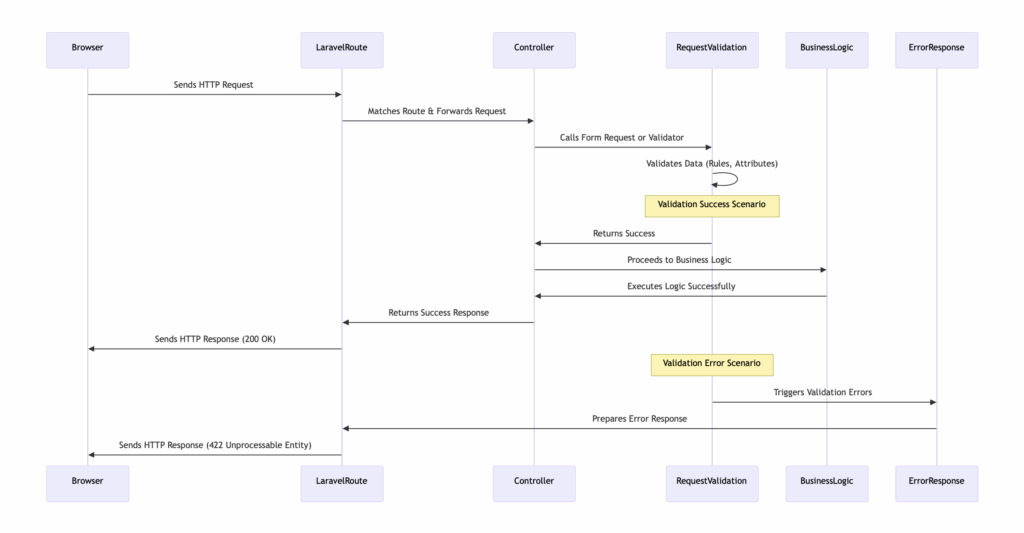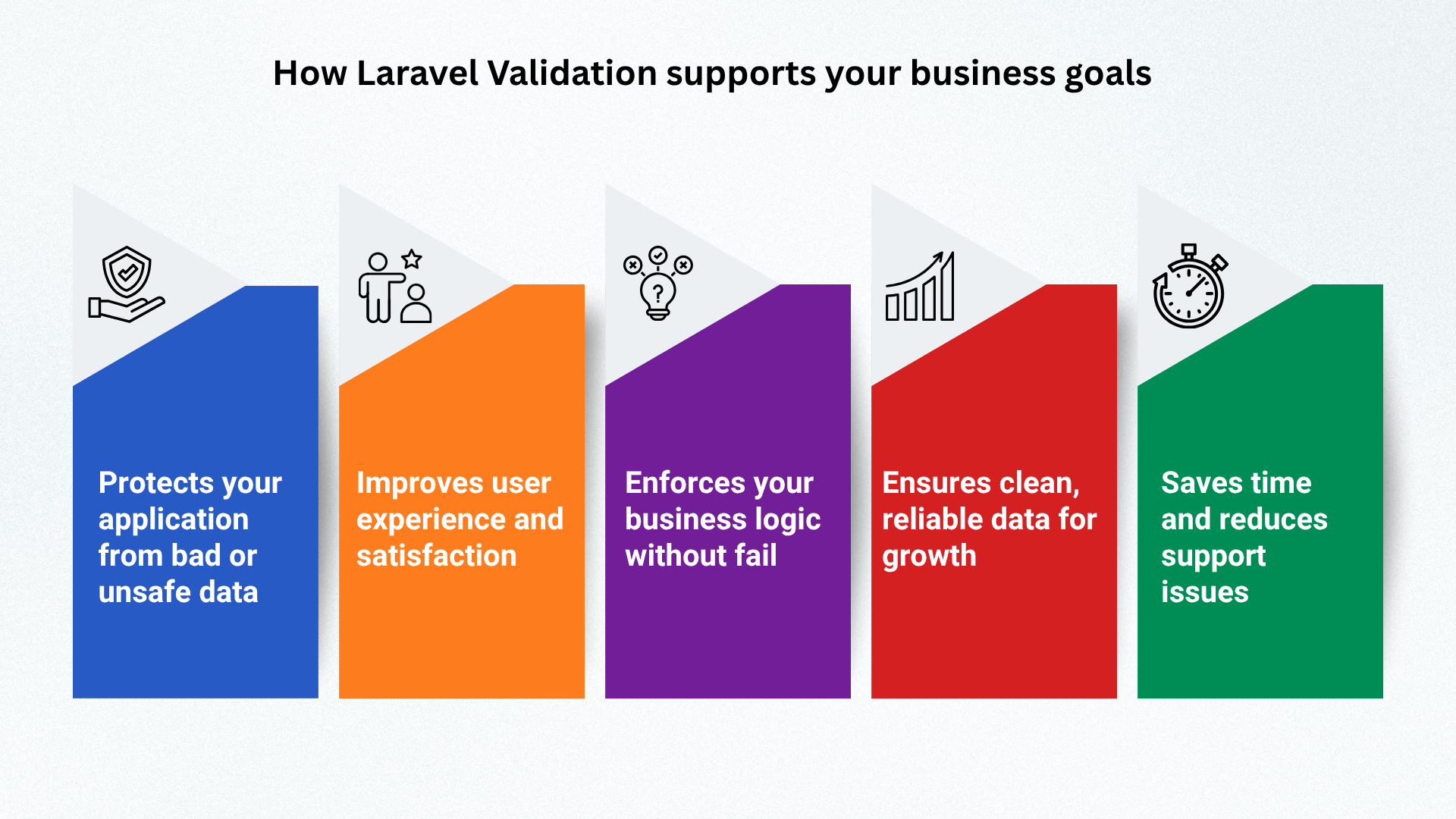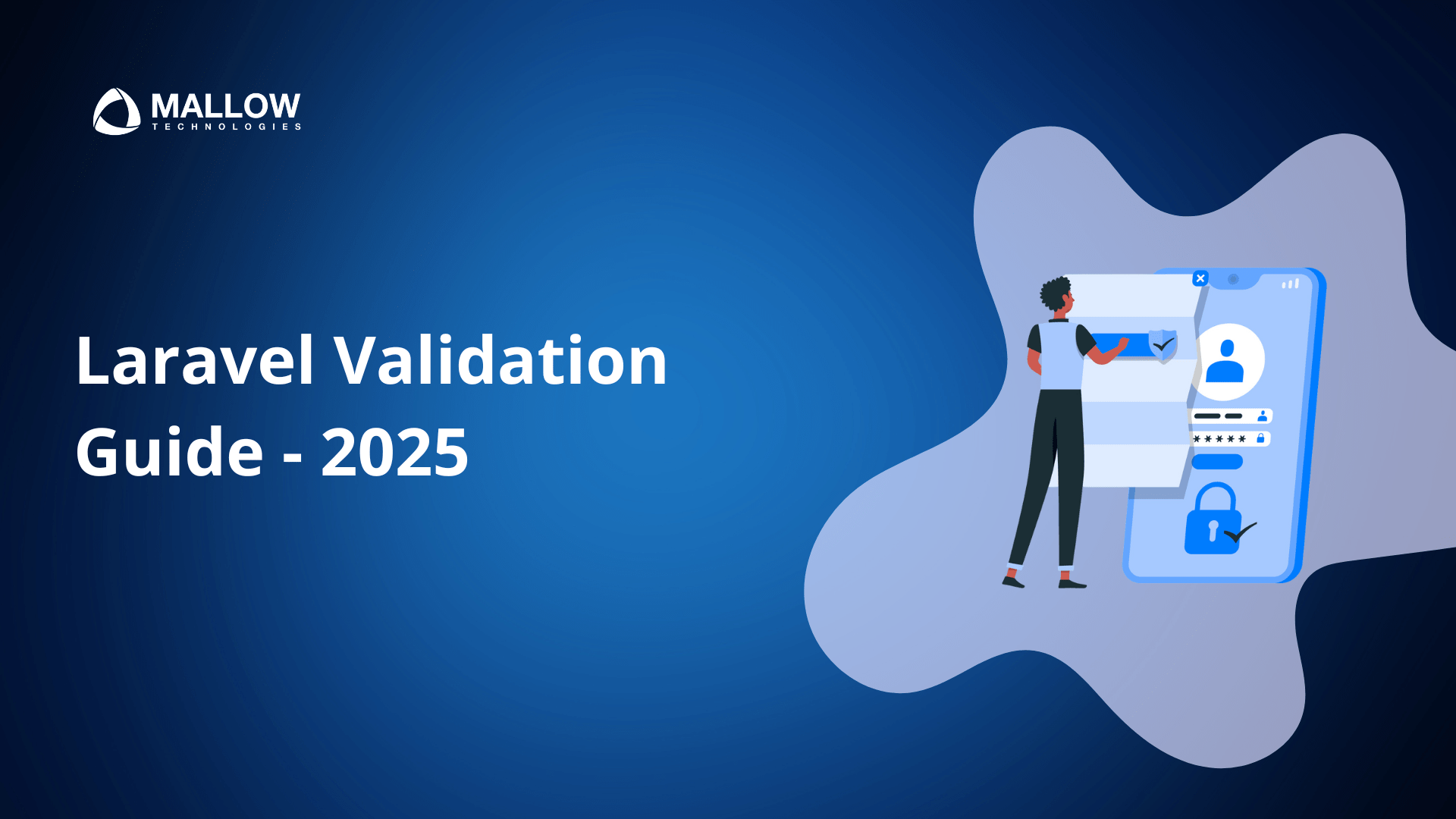Are validation errors causing frustration for your users or exposing your application to security risks?
Imagine users abandoning your platform because of poor validation handling or your development team scrambling to fix security vulnerabilities caused by insufficient input checks. Without robust validation, your application risks losing both data integrity and customer confidence, ultimately driving up maintenance costs and stalling business growth.
At Mallow, we’ve mastered the art of crafting secure, efficient, and business-focused applications for more than 10 years now. With expertise in prioritizing data integrity, and creating tailored solutions with clear validations, we ensure your applications remain robust and user-friendly. Our cost-effective, scalable practices minimize maintenance overhead while safeguarding security. Through these efforts, we’ve seen our clients achieve seamless user experiences, enhanced data security, and reduced development rework, leading to greater user trust, business growth, and sustained success in their business.
After going through this article, you’ll gain a clear understanding of how Laravel validation ensures data integrity and strengthens application security. You’ll discover actionable insights to implement validation strategies that align with your business objectives, along with practical tips to reduce development time and minimize maintenance costs.
Why Laravel Validation matters for your business application?
As a business owner, your application’s success depends on how well it handles user input on whether it’s customer registrations, orders, support tickets, or payment details. Every form a user fills out is a potential entry point for mistakes, inconsistencies, or even malicious attempts.
That’s where Laravel Validation plays a critical role. It acts as a protective layer that checks incoming data before it reaches your database or triggers business logic. Laravel ensures that only clean, complete, and correctly formatted data is accepted, reducing the risk of errors and improving the overall quality of your system. For more in-depth insights into Laravel Validation, refer to this comprehensive documentation from Laravel, which will guide you on how to implement robust validation rules effectively, enhancing your application’s reliability and security.
Here’s why this matters to you:
- Avoid costly errors – Prevents bad data from disrupting operations.
- Boosts security – Blocks unsafe or malicious inputs before they reach your system.
- Improves user experience – Gives clear error messages that help users correct mistakes.
- Enforces business rules – Ensures data meets your specific requirements (e.g. valid discount codes, age limits).
- Keeps your data clean – Reliable data supports better reporting, automation, and growth.
Client-side vs Server-side Validation - what’s the difference and why it matters?
When users submit data through your app, validation ensures it’s correct and safe. This can happen in two places:
- Client-side: in the user’s browser, before the data is sent to your server
- Server-side: on your server, after the data is submitted
Understanding the difference helps you build more secure and reliable business applications.
Comparison: Client-Side vs Server-Side Validation
Feature | Client-Side Validation | Server-Side Validation (Laravel) |
Where it happens | In the browser | On the server |
Speed | Very fast, instant feedback | Slight delay (requires form submission) |
Can it be bypassed? | Yes, by disabling JavaScript or using tools | No, it’s fully controlled on the server |
Security enforcement | ❌ Not secure | ✅ Fully secure and tamper-proof |
Business rule support | Basic (e.g. required fields) | Advanced (e.g. discount rules, age limits) |
User experience | Excellent (real-time feedback) | Moderate (on submit) |
Required for compliance | Optional | ✅ Essential for secure applications |
Why do you need both client-side and server-side validation?
Client-side validation helps users correct mistakes quickly. But server-side validation is essential for protecting your business. A savvy user or malicious actor can bypass client-side checks, but they can’t bypass Laravel’s server-side validation.
Getting started with Laravel Validation rules
Laravel comes with a rich set of built-in validation rules that help ensure your application only accepts valid and trustworthy data. These rules can be applied to everything from form fields to API requests, making them a powerful tool for maintaining data quality from day one.
What are Validation rules?
Validation rules are instructions that tell Laravel what kind of input is acceptable. For example:
- required – the field must be filled out
- email – must be a valid email format
- numeric – must be a number
- min:8 – must be at least 8 characters or more
- unique:users,email – value must not already exist in the database
Each validation rule serves to ensure specific input types while preventing errors or misuse. Curious to dive deeper into Laravel’s validation rules? Explore this detailed documentation from Laravel to gain a comprehensive understanding and apply them effectively in your applications.
How to apply rules in Laravel?
Laravel allows developers to apply these rules in different ways, most commonly:
- Directly in the controller using the validate() method
- Using Form Request classes
Here’s a quick example of validating a user registration form:
This ensures that:
- A name is entered
- The email is valid and not already taken
- The password is long enough and matches the confirmation field
Understanding and using the right rule helps enforce data quality and aligns inputs with your business goals.
Using form request classes for cleaner, more maintainable validation
As your business application grows, so does the complexity of your forms and the rules they need to follow. Relying on inline validation directly in every controller can quickly lead to messy, repetitive, and hard-to-maintain code.
Laravel solves this with Form Request classes, a powerful way to separate validation logic from business logic, making your code cleaner, more organized, and easier to scale.
What is a form request class?
A Form Request class is a dedicated file that handles all the validation (and authorization) logic for a specific form or API request. Instead of adding rules directly into your controller, you create a separate class to define what’s valid.
Example: Instead of this inside a controller:
You use a dedicated request class like this:
Then, in your controller:
What benefits can you gain for your Laravel application?
Benefit | What it Means for You |
Cleaner Code | Developers don’t repeat validation rules in multiple places |
Better Maintenance | Rules for each form are centralized in one place |
Easier Debugging | Issues are easier to track and fix when code is well structured |
Scalability | As your app grows, this structure helps manage complexity |
Improved Collaboration | Teams can work more efficiently with clear separation of logic |
How to create one?
Laravel makes it easy to generate a request class:
php artisan make:request RegisterUserRequest
The developer then defines rules in the rules() method and can also handle authorization in the authorize() method.
Form Request classes also work seamlessly with API and AJAX validation. Laravel automatically returns structured error messages, which makes front-end development smoother and improves the end-user experience.
As seen above, Laravel’s validation process ensures that incoming data complies with specified rules, safeguarding your application’s integrity effectively. This diagram illustrates the lifecycle of request validation in Laravel, starting from the browser and passing through the framework’s core components. It showcases how Laravel validates incoming data against defined rules before proceeding with further actions.

Handling and customizing Validation error messages in Laravel
When a user enters incorrect or incomplete data, clear error messages make all the difference. Laravel automatically generates these messages when validation fails—but what sets it apart is how easily those messages can be customized to match your tone, branding, or audience. Developers can override default messages by defining custom messages within the Form Request class, as detailed in the Laravel documentation.
Default error messages that just work
Laravel provides sensible default messages out of the box. For example, if someone forgets to enter an email address, Laravel will respond with:
“The email field is required.”
This helps users understand what went wrong without any extra effort from your developers.
Customize messages for clarity and tone
You can make these messages more user-friendly, branded, or specific to your audience. For instance:
Customize messages for clarity and tone
You can make these messages more user-friendly, branded, or specific to your audience. For instance:
Seamless localization for global users
Laravel also supports localization, meaning your validation messages can appear in multiple languages based on the user’s settings. The framework’s localization features provide a convenient way to retrieve strings in various languages, enhancing user experience for a global audience. This is managed using language files stored in your app, such as:
resources/lang/en/validation.php
resources/lang/es/validation.php
resources/lang/fr/validation.php
Laravel will automatically select the correct language based on the user’s preference or browser settings.
How can custom rules, conditional Logic, and nested data enhance Validation?
As your application grows, basic validation rules might not be enough. Real-world business scenarios often require more control—like validating complex forms, applying rules based on user roles, or checking dynamic data structures.
Laravel gives developers powerful tools to handle these advanced cases cleanly and efficiently.
Custom Validation Rules
Sometimes, your business has unique rules that can’t be handled with built-in validators. Laravel allows developers to write custom validation logic.
Example:
- Validate that a promo code is still active and not already used
- Ensure a booking time doesn’t overlap with another user’s reservation
Laravel lets developers create Rule classes or use closure-based rules for flexible validation tailored to your exact needs.
This ensures your business logic is enforced every time—no workarounds, no exceptions.
Conditional Validation
Some rules should apply only in certain situations—like when a specific user type is filling out a form, or only if a checkbox is selected.
Laravel supports conditional validation using directives like ‘sometimes’, ‘required_if’, and ‘required_unless’. These directives allow validation rules to apply only under certain conditions, enhancing the flexibility of form validations. The Laravel documentation provides comprehensive details on these conditional validation rules.
Laravel supports this with sometimes, required_if, required_unless, and other conditional directives.
Example:
- If the user selects “Company,” then the “Company Name” field becomes required
- If payment type is “Credit Card,” then card details must be validated
‘company_name’ => ‘required_if:user_type,company’,
This helps your app stay flexible and user-friendly—only showing rules when they’re relevant.
Validating Nested Data & Arrays
In modern applications, users often submit dynamic lists, nested forms, or grouped data. Laravel can validate all of it using dot notation and * wildcards.
Example:
A shopping cart submission with multiple items:
This ensures every product and quantity submitted is valid, no matter how many items are in the cart.
These advanced techniques help Laravel handle real-world data challenges without complicating the codebase. Whether you’re validating a dynamic order form or enforcing business-specific logic, Laravel provides the flexibility to do it cleanly and reliably.
How Laravel Validation helps you as a business owner

Validation may seem like a behind-the-scenes technical detail—but for business application owners, it plays a critical role in product quality, user trust, and operational efficiency.
Laravel’s validation system doesn’t just stop bad data—it brings real, measurable value to your business.
- Protects your application from Bad or Unsafe Data – Validation blocks incomplete, invalid, or malicious data before it reaches your business logic—reducing bugs, failed processes, and security risks.
- Improves user experience and satisfaction – Laravel returns clear, actionable error messages that help users fix issues quickly. This leads to smoother form submissions, fewer drop-offs, and better customer satisfaction.
- Enforces your business logic without fail – Whether it’s a minimum order amount or a time-sensitive booking, Laravel ensures your specific business rules are consistently followed—without extra manual checks.
- Ensures clean, reliable data for growth – Good data powers automation, analytics, and decision-making. Laravel validation helps ensure that what goes into your system is structured, clean, and trustworthy.
- Saves time and reduces support issues – Centralized and reusable validation rules not only speed up development but also reduce the volume of user errors—leading to fewer support tickets, faster troubleshooting, and better operational efficiency.
What are the best security practices?
Strong validation is the foundation of a secure, stable, and scalable Laravel application, shielding it from data vulnerabilities, enhancing the user experience, and minimizing long-term maintenance challenges. However, validation alone isn’t enough to fully safeguard your platform. Security requires a holistic strategy that addresses potential vulnerabilities at every level.
That’s why our article, 14 best security practices to follow for your Laravel application, is a must-read for anyone serious about building a robust and future-ready system. This comprehensive guide dives into proven strategies to protect sensitive data, prevent breaches, and ensure compliance with modern security standards. By applying these practices, you can build trust with your users, avoid costly disruptions, and confidently support your application’s growth.
Still unsure about your next step? Feel free to get in touch with our team.
What happens after you fill-up the form?
Request a consultation
By completely filling out the form, you'll be able to book a meeting at a time that suits you. After booking the meeting, you'll receive two emails - a booking confirmation email and an email from the member of our team you'll be meeting that will help you prepare for the call.
Speak with our experts
During the consultation, we will listen to your questions and challenges, and provide personalised guidance and actionable recommendations to address your specific needs.
Your queries, our answers
Laravel offers a clean, well-structured framework with built-in tools for data validation, authentication, and error handling, helping businesses launch faster without compromising stability. Its flexibility allows our team to build scalable, secure, and easy-to-maintain applications tailored to your business needs.
Validation shouldn't be treated as an afterthought. We define clear validation rules early in the development cycle, integrate automated tests to prevent regressions, and ensure data integrity at every layer, from form input to API communication.
We begin with a validation audit, analyzing your existing rules, form requests, and backend logic. Based on findings, we optimize or rebuild your validation flow, implement automated testing, and ensure every user input is handled securely and predictably.
The timeline depends on your project’s size and current codebase quality. Typically, we start with an assessment phase, followed by rule implementation, test coverage setup, and deployment. Our goal is to enhance validation without disrupting existing functionality.
We implement strict input sanitization, type checking, and rule-based validation to prevent vulnerabilities like SQL injection or cross-site scripting. For industries with specific compliance needs, such as healthcare or finance, our validation workflows are tailored to meet regulations.
Absolutely. Laravel validation integrates seamlessly with modern front-end frameworks like React, Vue.js, and Angular, as well as mobile and API-driven architectures. We ensure validation rules remain consistent across both front-end and back-end layers for a unified user experience. However, achieving this consistency often requires updates in the frontend and API layers as well — implementing proper error-handling logic to ensure that users receive clear, actionable feedback when validation errors occur.
We follow clean coding standards, modular validation design, and thorough documentation — making it easier to scale or adapt your application in the future. Beyond development, our ongoing support ensures that your Laravel app remains robust as your business evolves.
Robust validation in Laravel helps catch data errors early — before they ripple through your system and cause costly bugs or data inconsistencies later. When your validation logic is clearly defined and modular, it minimizes the need for repeated fixes, reduces user-reported issues, and simplifies testing during future updates. For your business, that means lower maintenance costs, fewer unplanned downtimes, and a more stable application that scales smoothly as your user base grows.
Author
Anandhan
Anandhan is a passionate technical lead at Mallow, where he plays a crucial role in driving innovation and overseeing the development of cutting-edge solutions. With a wealth of experience in the field of technology, he consistently strives to elevate his team's performance and deliver exceptional results. His multifaceted interests inspire him to approach challenges with creativity and an open mind, leading to innovative solutions that transcend conventional boundaries. Beyond his professional endeavours, Anandhan nurtures a love for literature and cinema. During his free time, you'll often find him engrossed in the pages of books across various genres, exploring diverse narratives and gaining insights from authors around the world.



